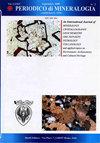An Investigation on Antenna Substrate Materials for the Design of 5X20 Massive MIMO Antennas
IF 1.2
4区 地球科学
Q3 GEOCHEMISTRY & GEOPHYSICS
引用次数: 0
Abstract
— The wireless technology resides at 5G global standard wireless communication. This standard enhances the network capacity, network coverage, lower latency and enormous bandwidth by increasing the operating frequencies of the communication standards. 5G standard promises to deliver a speed of 500 times faster than 4G by utilizing the technology such as massive MIMO, small cell, beam forming and full duplex technology. The higher operating frequencies leads to the path loss constrains and the device compact also one of the issues arises in the handheld wireless communication devices or massive machine type communications. To overcome these issues an effective antenna has to be designed for the new generation wireless standards. Most commonly used handheld communication devices, IoT devices and massive machine type communication uses microstrip patch antenna as radiating elements and the substrate materials associated with these antennas plays a key role for the development of an antenna. In this paper, investigations on six different substrate materials were done for the design of MIMO antenna. A rectangular microstrip antenna was designed under the operating frequency of 28 GHz using six different substrate materials such as Taconic TLY-5A, Arlon Diclad 880, Rogers Utralam, Rogers RO 3003, Rogers RO 3035 and Arlon AD 450. From this analysis an Arlon Diclad 880 substrate material is best suited for the developement of an array. An array of 10 elements and 100 elements microstrip patch antenna has been designed and simulated using CST microwave studio suite. A planar microstrip antenna array (2X5) was designed using Arlon Diclad 880 substrate material having the dielectric constant of 2.2 and a thickness of 0.127 mm, it gives a maximum gain of 13.74 dBi at 27.9 GHz, directivity of 14.29 dBi and the overall dimensions of 10×22.5×0.127 mm where as 5X20 massive MIMO antenna array gives a maximum gain of 23.66 dBi at 28.1 GHz, directivity of 24.15 dBi and the overall dimensions of 145×22.5×0.127 mm. Further slots will be introduced in the antenna for even more size reduction in the conventional microstrip patch antenna for the 5G wireless handheld communication devices and the IoT applications. Wireless Technology, Massive MIMO Antenna, 5X20 Antenna elements.面向5X20大规模MIMO天线设计的天线基板材料研究
—无线技术驻留在5G全球标准无线通信。该标准通过增加通信标准的工作频率,提高了网络容量、网络覆盖、降低了延迟和巨大的带宽。5G标准通过利用大规模MIMO、小蜂窝、波束形成和全双工技术等技术,承诺提供比4G快500倍的速度。较高的工作频率导致路径损耗的限制和设备的紧凑性也是手持式无线通信设备或大规模机器型通信中出现的问题之一。为了克服这些问题,必须为新一代无线标准设计有效的天线。最常用的手持通信设备、物联网设备和大型机器类型通信使用微带贴片天线作为辐射元件,与这些天线相关的衬底材料对天线的发展起着关键作用。本文针对MIMO天线的设计,对六种不同的衬底材料进行了研究。采用Taconic TLY-5A、Arlon Diclad 880、Rogers Utralam、Rogers RO 3003、Rogers RO 3035和Arlon AD 450 6种基片材料,设计了工作频率为28 GHz的矩形微带天线。从这个分析来看,Arlon Diclad 880衬底材料最适合于阵列的开发。利用CST微波工作室套件设计并仿真了10元和100元微带贴片天线阵列。采用介电常数为2.2、厚度为0.127 mm的Arlon Diclad 880衬底材料设计了平面微带天线阵列(2X5),在27.9 GHz时最大增益为13.74 dBi,指向性为14.29 dBi,外形尺寸为10×22.5×0.127 mm,而5X20大规模MIMO天线阵列在28.1 GHz时最大增益为23.66 dBi,指向性为24.15 dBi,外形尺寸为145×22.5×0.127 mm。为了进一步缩小传统微带贴片天线的尺寸,5G无线手持通信设备和物联网应用将在天线中引入更多的插槽。无线技术,大规模MIMO天线,5X20天线元件。
本文章由计算机程序翻译,如有差异,请以英文原文为准。
求助全文
约1分钟内获得全文
求助全文
来源期刊

Periodico Di Mineralogia
地学-地球化学与地球物理
CiteScore
1.50
自引率
14.30%
发文量
0
审稿时长
>12 weeks
期刊介绍:
Periodico di Mineralogia is an international peer-reviewed Open Access journal publishing Research Articles, Letters and Reviews in Mineralogy, Crystallography, Geochemistry, Ore Deposits, Petrology, Volcanology and applied topics on Environment, Archaeometry and Cultural Heritage. The journal aims at encouraging scientists to publish their experimental and theoretical results in as much detail as possible. Accordingly, there is no restriction on article length. Additional data may be hosted on the web sites as Supplementary Information. The journal does not have article submission and processing charges. Colour is free of charges both on line and printed and no Open Access fees are requested. Short publication time is assured.
Periodico di Mineralogia is property of Sapienza Università di Roma and is published, both online and printed, three times a year.
 求助内容:
求助内容: 应助结果提醒方式:
应助结果提醒方式:


